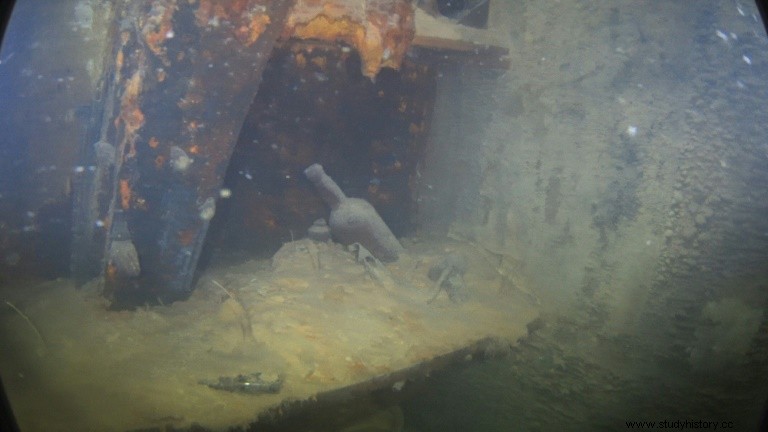More than 170 years after the mysterious disappearance of the British ship HMS Terror in the Canadian Arctic, never-before-seen images of the wreck have been released:they reveal a well-preserved interior that could shed new light on this legendary expedition.

First images of the wreck of the Terror, a ship of British explorer Jhn Franklin which was wrecked in 1846 off the coast of the Canadian far north. Images released on August 28, 2019 by the Canadian government.
The Terror was one of two ships in English explorer John Franklin's expedition, which set out from Great Britain in 1845 in search of the Northwest Passage, which connects the Atlantic and Pacific oceans via the Arctic. Surprised by the cold, the 129 sailors of the expedition were stuck in the ice for a year and a half before dying of starvation, cold and lead poisoning.
Diving in freezing water
The circumstances of the greatest tragedy of Arctic exploration, which was the subject of an American television series (The Terror), have remained unclear ever since. The first ship, HMS Erebus, was found in 2014 in the same area. Images taken by divers and the Parks Canada Agency's remote-controlled submersible robot reveal intact artifacts of life on the ship. The wreckage was found in 2016 at a depth of 24 meters off King William Island in the Northwest Passage, east of Cambridge Bay in the territory of Nunavut.
"We had the impression, while exploring HMS Terror, that it was a ship recently abandoned by its crew, seeming to have escaped the passage of time ", said in a press release Ryan Harris, director of the archaeological project and pilot of the remote-controlled vehicle used for the excavations. During 48 dives, including seven with the robot, "in water that approached zero degrees or less ", the team obtained images of more than 90% of the lower deck of the boat.
The boat was found resting upright on its keel on the seabed, with the propeller still in place, the anchor up, and the skylights uncovered, suggesting the early abandonment of the ship, Harris noted. The sediments that covered the bedroom of the ship's captain, Francis Crozier, allowed the preservation of his office, in which researchers expect to find scientific instruments and maps.
Only the captain's personal quarters remain inaccessible, due to a closed door. Researchers hope to find sealed written records there that the cold water and sediment may have preserved. "The writings could clarify what happened, the chronology of events, when the boats separated and how they got to where they were left behind “, explained Mr. Harris in a press conference.

First images of the wreck of the Terror, a ship of British explorer John Franklin that sank in 1846 off the Canadian far north. Image released August 28 by the Canadian government. (Parks Canada Agency/AFP - Ryan Harris)
An iron shell
Terror and Erebus set out from Britain equipped with an iron-clad hull for ice, steam engines and provisions for three years in the Arctic. A boat sponsored by Franklin's widow, Lady Jane, found a message on King William Island in 1859 that revealed part of the mystery. According to this, the explorer and 23 crew members died on June 11, 1847 in unknown circumstances. On April 22, 1848, 105 survivors would have left the ships on foot to reach the mainland by the ice, still according to this message. None survived.
Archaeological research was carried out in partnership with Inuit organizations, whose oral testimonies transmitted from generation to generation made it possible to locate the wrecks. Inuit communities in the Arctic will be the first to see the artifacts of Terror, of which they are legal co-owners. Roald Amundsen, the Norwegian explorer who successfully crossed the Northwest Passage for the first time in 1905, spent two winters in the ice near King William Island. Ryan Harris and his team hope to return to continue the search next year, in particular to explore Captain Crozier's cabin. "You never know what you'll find in this last uncharted space ".
